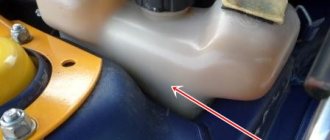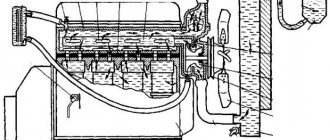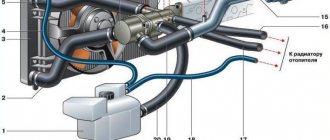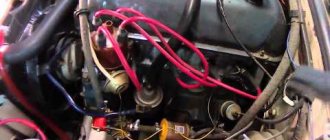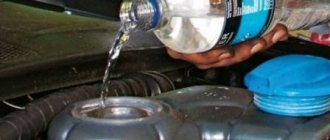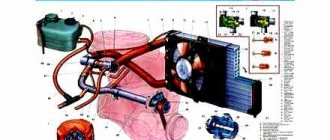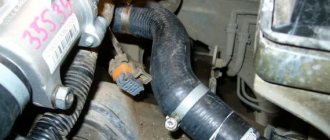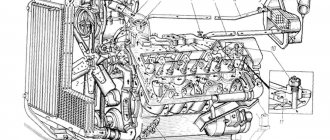VAZ-2114 – the engine gets hot: causes and repairs. Thermostat VAZ-2114
An internal combustion engine is called that because the process of fuel combustion occurs inside its cylinders. In this case, a huge amount of thermal energy is released, which, thanks to the crank mechanism, is converted into mechanical energy. The temperature often exceeds 2000 degrees. No metal, no matter how strong and stable it is, can withstand such a load for long. It is precisely in order to reduce the thermal load and ensure normal temperature conditions for engine operation that the cooling system serves. If it malfunctions, the car’s power unit begins to overheat, as a result of which engine parts expand, lubricant boils, and gaskets burn out. The result of such a destructive process may be failure of the elements of the piston group and the cylinder head. To prevent such an outcome, it is important to know the possible causes of engine overheating and be prepared to eliminate them immediately.
Signs indicating that the engine is overheated
Let's consider how the VAZ-2114 power unit behaves when its operating temperature exceeds the norm. The cooling system of this car is not much different from that of other cars, except perhaps in the simplicity and unreliability of its design. So, when the engine of the “fourteenth” overheats, it lets you know about it with the following signs:
- the arrow of the coolant temperature sensor goes far into the red zone;
- The radiator cooling fan operates in constant mode;
- a specific smell appears in the cabin from boiling antifreeze (antifreeze);
- A cloud of thick, sharp-smelling steam appears from under the hood - evidence of boiling refrigerant.
What to do if you overheat
If, thanks to the listed signs, you understand that your VAZ-2114 engine is heating up more than normal, follow these steps:
- turn off the engine immediately;
- roll the car closer to the side of the road (if you are on the road);
- turn on the ignition and double-check the temperature sensor readings;
- lift the hood, inspect the engine compartment to determine the location of the coolant leak;
- pay attention to the amount of antifreeze (antifreeze) in the expansion tank, but under no circumstances open it while the liquid is hot;
- try to determine the cause of overheating.
In such a situation, it is better to deliver the car to the place of repair (to a service station or garage) by towing, but if this place is located no further than 1-2 km, as a last resort, you can take a risk and get there on your own. Naturally, periodically letting the engine cool down when the sensor needle exceeds 90 degrees.
What to do if the engine overheats
You can diagnose engine overheating very simply: this will be shown by the arrow of the coolant status indicator. If the engine temperature exceeds the normal temperature, you need to immediately stop the car and make a stop with the emergency indicator displayed.
When antifreeze boils in the expansion tank, you must stop and let the car cool down.
The following recommendations should then be followed:
- It is necessary to open the hood of the vehicle to increase the cooling rate of the engine
- Do not open the radiator cap or expansion tank. This may result in burns or other injuries.
- Do not pour ice water on a hot engine, as a sudden change in temperature can lead to the formation of cracks, which will lead to expensive repairs.
- Do not perform any actions until the boil stops. Only after this you need to carefully open the expansion tank and fill in antifreeze to the required level
- After this, start the car and check the operation of the cooling system. In the event that the engine temperature reaches its maximum very quickly, you need to move exclusively by means of a cable. If the temperature rises slowly, then it is possible to drive to a service center or to a garage, where the necessary work will be done to eliminate the malfunction
Why does the engine on a VAZ-2114 get hot?
Considering that the cooling system of the “fourteenth” is quite simple, it is quite possible to bring it into working condition on your own. But first, let's look at the main reasons for engine overheating. They can be:
- insufficient amount of coolant in the system;
- the liquid pump (pump) is faulty;
- The radiator fan switch sensor has failed;
- blown fan fuse;
- the fan itself is broken;
- the radiator fins are clogged;
- The thermostat has failed;
- The expansion tank plug is faulty.
Let's look at these reasons in more detail.
Coolant boiling
If antifreeze (antifreeze) boils, make sure:
- Does the radiator fan work and when does it turn on? The sensor may be faulty;
- Is the thermostat working? The coolant constantly moves in a small circle, thereby not cooling;
- Is the pump working?
- Is the cooling system, including the radiator, clogged?
- Is the system airy?
- Is the valve on the lid working properly? Low pressure in the system can cause premature boiling of the antifreeze.
Insufficient coolant
Do you remember for sure that yesterday the refrigerant level was normal, but today in your VAZ-2114 the engine is heating up and the expansion tank is empty? This means that the tightness of the system was broken. And it’s good if only outside the engine. The worst thing in this case is the burnout of the cylinder head gasket. This malfunction is insidious in that liquid from the channels of the cooling jacket can get inside the cylinders, as well as into the oil channels. Because of this, the engine of the VAZ-2114 often gets hot and the car stalls. The operation of the engine is accompanied by a bluish exhaust with a characteristic odor. Here you will have to remove the cylinder head and flush the lubrication and cooling systems. In the worst case scenario, the engine will need to be overhauled.
More often, coolant leaves the system through the connections between hoses and radiator pipes (cooling and heater), thermostat, expansion tank, and engine. If the engine of a VAZ-2114 heats up and a coolant leak is obvious, check these places first! This problem is solved by tightening the clamps and adding fluid to the cooling system.
Next, inspect the hoses themselves. Often they simply crack over time, and antifreeze or antifreeze, being under pressure, flows out of the system. Such a malfunction can be eliminated by replacing one or another hose.
Temperature and causes of boiling
Boiling fluid in the engine is a fairly common breakdown that occurs as a result of any malfunction in the cooling system. If the engine boils, then driving the vehicle is strictly prohibited, since frequent boiling may cause the engine to fail altogether. Then major repairs may not even help the car owner.
There can be several faults that can cause any refrigerant to boil in the expansion tank. But all of them are associated with breakdowns that lead to overheating of the motor. The boiling point of "Antifreeze", be it blue, red or green, is 100 degrees Celsius, but liquid manufacturers, as a rule, increase this figure to 108 degrees. As for traditional antifreezes, they also boil at the above temperature.
Blue and green refrigerants
It is impossible to specifically indicate the temperature to the nearest degree, since it is determined by each manufacturer.
Let's consider malfunctions that can cause refrigerant boiling:
- thermostat malfunction;
- malfunction of the radiator of the cooling system;
- malfunction of the centrifugal pump (pump);
- insufficient refrigerant level in the system;
- fan failure;
- air lock in the cooling system;
- failure of the refrigerant temperature sensor.
Thermostat. If this element breaks, its valves will jam in one position. That is, the refrigerant will flow in the system through one of the circulation circles (small), and the liquid will not be able to cool properly. So the antifreeze will boil and this can be seen by opening the cap of the expansion tank, since vapors from the system will exit through the tank.
To find out which thermostat is working or not, you need to open the hood and find two pipes leading to it. These hoses carry fluid to and from the radiator. If the pipe supplying coolant to the radiator is hotter than the second hose, then it’s time to change the thermostat.
A clogged radiator is one of the reasons for engine boiling.
The cooling radiator can also cause fluid to boil in the system.
It fails in several cases:
- if the radiator core is clogged with dust and sediment from “Antifreeze” (in this case, the air flow passing through it is reduced);
- scale and sedimentation inside the pipes (the thermal conductivity of the hoses is significantly reduced, as a result of which the liquid is not cooled sufficiently);
- the vehicle moves at low speed (the air flow through the radiator core to cool the antifreeze is insufficient).
The refrigerant can also boil in the cooling system if the pump is not operating efficiently. In particular, this applies to those engines where the pump pulley receives torque separately from the gas distribution device. In this case, a decrease in the pulley rotation speed may occur due to a weakening of the drive belt tension. If the belt is loose, the rate of circulation of the refrigerant is significantly reduced, which can cause it to boil.
Failure of the cooling fan, the formation of an air lock, as well as insufficient fluid level in the tank can cause the engine to boil in the system.
Car engine boiling
Liquid pump failure
The role of the pump in the cooling system is to create pressure through which the refrigerant circulates. Its failure can not only cause the VAZ-2114 engine to overheat, but also cause a malfunction of the gas distribution mechanism drive. The fact is that the liquid pump is driven through a gear by a timing belt. Therefore, if the pump fails, it immediately affects the performance of the entire drive. In this case, the fluid pump and possibly the timing belt will need to be replaced.
Fan sensor malfunction
Failure of the fan switch sensor leads to the fact that during slow driving the radiator does not receive any forced airflow. In other words, the fan simply does not turn on and the liquid does not cool. Checking the sensor is easy. For “fourteeners” with carburetor engines, it is enough to turn on the ignition, disconnect the terminals from the sensor located on the radiator, and short them together. If the fan starts working, the sensor needs to be replaced. If the VAZ-2114 engine (8-valve injector) heats up, with the ignition on, simply remove the terminals from the coolant temperature sensor located on the right of the cylinder block. The electronic control unit will command the engine to operate in emergency mode, and the fan will have to turn on. If this happens, replace the sensor.
But there is one more nuance here - a fuse. If it burns out, the fan, of course, will not turn on. In the mounting block under the hood, find fuse F4 or F8. It is indicated by the corresponding symbol - a propeller. Remove it from the socket and check it with a tester. Replace if necessary.
Why the car boils: causes of coolant overheating
The cooling system in a car is one of the main peripheral organs that ensures normal engine operation. Antifreeze pipes pass through the most dangerous areas of the engine for overheating, and are also connected to the interior heater, which makes the system multifunctional and very important for the normal operation of the car. Do you think that the stove is not such an important element of comfort and overall usability? Try driving in 20-degree frost without it. You will clearly feel all the delights of such operation and will be able to understand exactly how important this element is in the car. But the stove is only part of the cooling system. The main parts of its operation are the thermostat, pipes through which coolant circulates, as well as a radiator for cooling antifreeze or antifreeze.
If one of these elements is not working properly, there may be a problem with the cooling system. Such problems will lead to the engine overheating, the pistons will change sizes due to metal expansion when heated, friction will increase significantly, and the engine will simply fail. It is important to notice overheating in time to eliminate this process and remove all risks from operating your own car. That is why the dashboard in any car contains information about what the coolant temperature is at the moment. Let's look at what problems cause the machine to boil.
Faulty thermostat
The VAZ-2114 thermostat is the main element for distributing coolant flows. It is he who regulates the direction of its movement when the engine is cold and when it is warm. The essence of the thermostat is to switch the refrigerant flow from a small to a large circle when it reaches a certain temperature. If it starts to jam, the motor will either take a very long time to warm up, or very quickly.
You can check the VAZ-2114 thermostat in the following way. Start the engine and warm it up to a temperature of 90-95 degrees. Without turning off the ignition, touch the lower radiator hose. If it is warm (hot), then everything is in order: the coolant circulates in a large circle and overheating due to the thermostat is excluded here. If the pipe is cold, get ready to replace this part.
Antifreeze (antifreeze) is boiling in the expansion tank
Using the example of the engine cooling system 21083 of VAZ 21083, 21093, 21099 cars, we will establish the causes of the malfunction: “antifreeze (antifreeze) is boiling in the expansion tank.”
Signs of a malfunction: “antifreeze (antifreeze) is boiling in the expansion tank”
Coolant (coolant) bubbles in the expansion tank of the engine cooling system 21083 during operation. The seething increases as the car engine warms up.
All this is accompanied by an increase in the liquid level in the expansion tank and coolant leakage under its cap. The lid may come off, the tank may crack, or the system hoses may break.
Causes of the malfunction: “antifreeze (antifreeze) is boiling in the expansion tank”
Engine overheating
Most often, engine overheating occurs due to a malfunction of the cooling system thermostat. Its valve, which jams in the closed position, does not allow antifreeze (antifreeze) to circulate in a large circle and cool in the radiator.
Tank cap
Another cause of overheating may be a plug in the expansion tank. It is designed in such a way as to maintain a certain pressure in the system, which is higher than atmospheric pressure. This is necessary to ensure that the water in the antifreeze or antifreeze does not boil at 100 degrees Celsius. If the plug is faulty and does not hold the required pressure, the coolant may boil prematurely. This will not cause significant overheating of the motor, but may cause problems with the operation of the system.
Cooling radiator
You may ask, what if all the main elements of the cooling system except the fan are working properly, but on the VAZ-2114 the engine heats up when driving, because the oncoming flow of air, even at average speed, can easily replace the propeller? There can only be one reason - the cooling radiator lamellas are clogged. Dirt, dust, leaves, branches, insects - all this settles in layers day after day, not allowing air to blow through the slats.
To prevent this situation, the radiator must be periodically washed with a stream of water to remove contamination.
